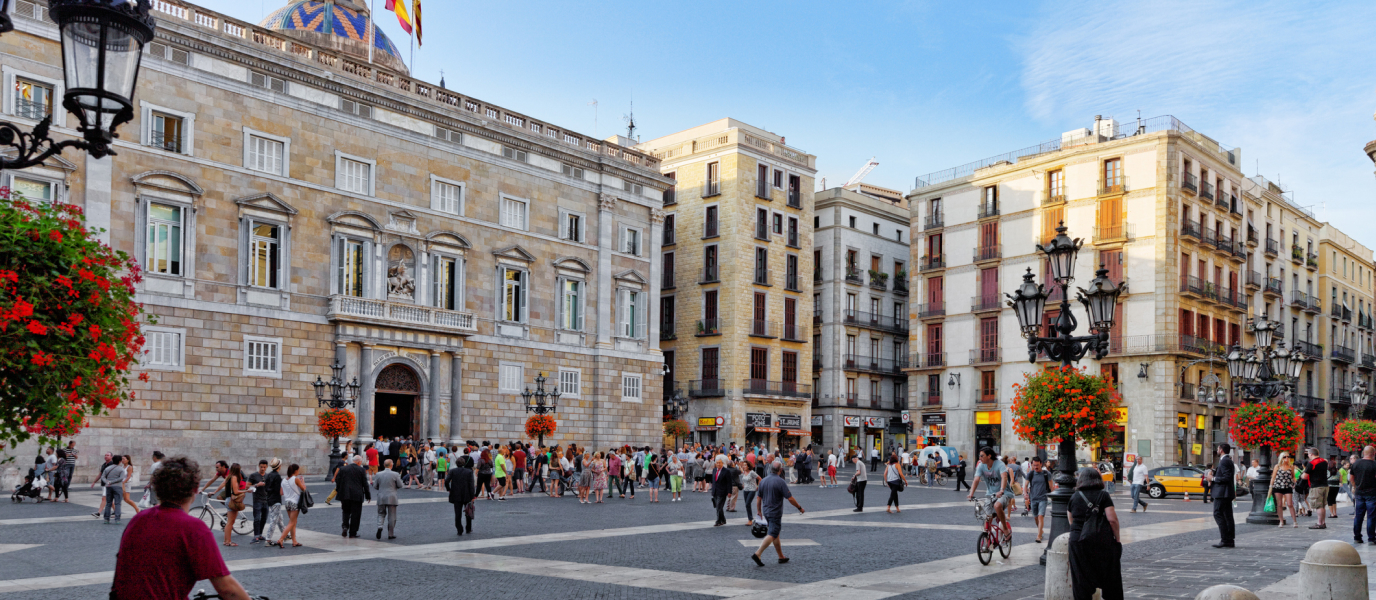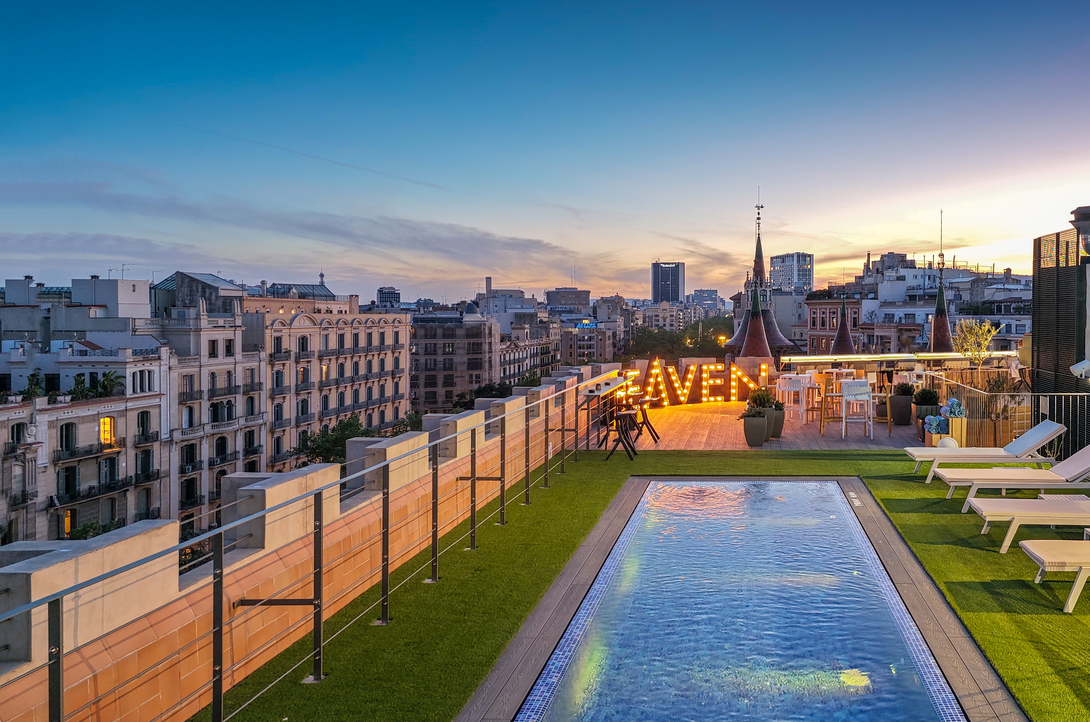Barcelona Cathedral—or, to give it its official name, Catedral de la Santa Creu i Santa Eulàlia—is an ancient church with a relatively modern façade. The fact is that the present Gothic cathedral stands on the site occupied since the fourth century by an Early Christian cathedral—the remains of which are still visible in the subsoil and in the City History Museum. The original church suffered serious damage during the invasion by the Arab warlord Almanzor in the tenth century, and was later replaced by a new church in the Romanesque style. Construction of the present Gothic church did not get under way until 1 May 1298, during the reign of Jaime II of Aragon, and continued over a period of 150 years. However, the façade which visitors now admire from the Pla de la Seu is much more recent; at the end of the nineteenth century, after it had remained unchanged for four hundred years, the Catalan industrialist Manuel Girona i Agrafel shouldered the cost of completing the new façade, on the occasion of the 1888 World Fair. A new façade had, in fact, been planned since the fifteenth century, but had never materialised. The architect Josep Oriol Mestres was responsible for building the Neo-Gothic façade, with its two lateral pinnacles, while Augusto Font Carreras put the finishing touches to the edifice with the 70-metre-high dome, completed in 1913.
The crypt of Saint Eulalia and the cloister: following the harrowing legend of the martyr
Dedicated to the Holy Cross since 599 AD, the old Early Christian cathedral acquired a second patron in the year 877. In that year, the basilica received the relics of Saint Eulalia, patron saint of the city of Barcelona, which had been found hidden in the church of Santa Maria del Mar. The powerful legend of this Christian martyr of the end of the third century explains the large number of elements in the cathedral dedicated to her: a door, stained glass windows, keystones, reliefs, images, etc. The story tells that the Romans inflicted 13 agonies on this maiden, one for every year of her life: from imprisoning and beating her, to torturing her on a rack, burning her breasts, and throwing her into a ditch of quicklime and a yard swarming with fleas. The ninth torment is the most famous, whereby she was put naked into a cask filled with broken glass, nails and knives and thrown down a steep street which was thereafter known as the Baixada de Santa Eulàlia. Finally, she was nailed to an x-shaped cross which today is the emblem of the cathedral.
The saint’s remains rest beneath the main altar in the Crypt of Saint Eulalia, in a spectacular Gothic alabaster sarcophagus, bearing carved scenes of her martyrdom, the work of Lupo di Francesco. In the beautiful Gothic cloister garden, filled with palm trees, magnolias and orange trees, there is a pond inhabited by thirteen white geese, in honour of Saint Eulalia, who was thirteen years old when she was tortured. The cloister holds many other curiosities not discernible to the untrained eye. On the ground are insignia representing merchants’ and artisans’ guilds, some of whose members earned the privilege of being buried there by virtue of their financial support for the cathedral’s construction. In a corner of the courtyard is a little fountain with a figure of San Jordi (Saint George in English) killing the dragon; it is said that casting a coin into this fountain will bring good luck. Every year during the festival of Corpus Christi, on the central spout of this fountain (dating from the fifteenth century), the traditional L’ou com balla takes place, which involves making an egg “dance” by placing it on the jet of water.

The Cathedral’s other patron, the Holy Cross, is also represented in the cloister by a series of reliefs showing the legend of the Tree of the Holy Cross, in addition to scenes from the Old and New Testaments. It is also worth pointing out that the statue adorning the great dome that crowns the cathedral (and which is the work of sculptor Eduard Alentorn) represents Saint Helena, mother of the Emperor Constantine who, according to legend, discovered the True Cross on Mount Calvary.
Other essential sights on your tour of the Cathedral
The scale and rich decoration of this church mean that the visitor, if so inclined, could spend hours exploring it. To give some figures to illustrate its vastness, Barcelona Cathedral has around 40 chapels, embellished with Gothic altarpieces by renowned Catalan artists including Guerau Gener and Bernat Martorell, 215 keystones and 200 gargoyles which, in addition to devils, feature an elephant, a bull and a unicorn. The church also has 21 bells headed by the rebel bell Honorata, which was recast during the nineteenth century after Philip V had ordered it to be destroyed after it had rung out to announce—and encourage—the 1714 uprising.

No tour of the cathedral should omit a walk through the Portal de Sant Iu, the oldest way into the cathedral, which served as its main entrance for five centuries. An inscription here reminds visitors of the exact date in 1298 when building of the cathedral commenced. Once inside, make sure you see the High Altar, which is supported on two pillars belonging to the early, sixth-century church, and which is dominated by the Exaltació de la Creu, surrounded by six angels—the work of the sculptor Frederic Marès. Other outstanding features of the church include the choir with its fifteenth-century carved wooden choir stalls, the Renaissance-style reliefs of scenes from the life of Saint Eulalia in the retrochoir, and the Romanesque chapel of Saint Lucia, dating from the thirteenth century, which also has an outside entrance as it was built as a chapel annexed to the episcopal palace.

The basilica also holds the remains of various members of royalty; particularly noteworthy are the tombs of Count Ramón Berenguer I, and his wife Almodis de la Marca—as well as the incorrupt body of Saint Olegarius, a twelfth-century bishop of Barcelona.
The final stop of our tour is on the terraces, which can be accessed by the lift from the chapel Capella dels Sants Innocents. From here, we gain a different perspective of the cathedral’s pinnacles, dome and roofs, as well as of the surrounding area.
Cathedral Museum
Located in the north gallery of the cloister, close to the Chapel of Santa Lucía, the museum was once the site of a soup kitchen for the poor and is also worth a brief visit. The outstanding works among its small collection of paintings are the fifteenth-century Gothic altarpiece Retaule de Sant Bernadí i l’Àngel Custodi, by the artist Jaume Huguet, and Pietat Desplà by Bartolomé Bermejo. The museum also houses relics including the baptismal font of the former Romanesque cathedral, as well as the cathedral’s greatest treasure—the Monstrance, a gold, silver and jewelled sacrarium which stands on the throne of King Martí I El Humano.








































































